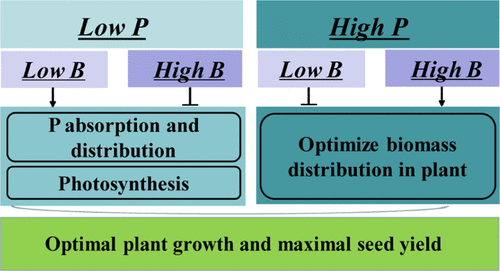当前位置:
X-MOL 学术
›
J. Agric. Food Chem.
›
论文详情
Our official English website, www.x-mol.net, welcomes your feedback! (Note: you will need to create a separate account there.)
Boron and Phosphorus Act Synergistically to Modulate Absorption and Distribution of Phosphorus and Growth of Brassica napus.
Journal of Agricultural and Food Chemistry ( IF 6.1 ) Pub Date : 2020-07-02 , DOI: 10.1021/acs.jafc.0c02522 Zhe Zhao 1 , Sheliang Wang 1 , Philip John White 1, 2 , Youqiang Wang 1 , Lei Shi 1 , Fangsen Xu 1
Journal of Agricultural and Food Chemistry ( IF 6.1 ) Pub Date : 2020-07-02 , DOI: 10.1021/acs.jafc.0c02522 Zhe Zhao 1 , Sheliang Wang 1 , Philip John White 1, 2 , Youqiang Wang 1 , Lei Shi 1 , Fangsen Xu 1
Affiliation

|
Rapeseed (Brassica napus L.) is highly susceptible to boron (B) and phosphorus (P) deficiencies, yet knowledge of how these two essential elements interact to contribute to plant growth and crop yield is limited. To this end, a pot experiment with three P application rates (5, 75, and 150 mg P2O5 kg–1 dry soil) and two B application rates (0.25 and 1 mg B kg–1 dry soil) was conducted. The results showed that high P combined with high B optimized plant growth and facilitated P distribution forward to seeds compared with high P and low B combination at the maturity stage. Under low P conditions, low B supply was more beneficial for P absorption at seedling and bolting stages and increased P distribution ratio in seeds at the maturity stage, resulting in higher photosynthetic efficiency and growth parameters than low P and high B combination. Interestingly, high B supply could upregulate the expression of the P-starvation-induced gene BnaC3.SPX3 and P transport genes in roots under low P conditions, so low B-facilitated P absorption appears to be a BnaPHT1s-independent process. Significant differences of B and P interaction on the seed yield, net photosynthetic rate, and total P absorption and distribution at the maturity stage between two cultivars might reflect the distinct genotypic properties. Overall, our findings highlight the importance of balanced B and P nutrition which acts synergistically to modulate growth and yield formation of B. napus either in nutrition deficiency or sufficiency.
中文翻译:

硼和磷协同作用调节甘蓝型油菜对磷的吸收和分布以及生长。
油菜籽(Brassica napus L.)对硼(B)和磷(P)缺乏症极易感,但对这两种必需元素如何相互作用以促进植物生长和作物产量的了解有限。为此,进行盆栽试验,其中三个P施用量(5、75和150 mg P 2 O 5 kg –1干燥土壤)和两个B施用量(0.25和1 mg B kg –1)干燥土壤)。结果表明,与高磷和低硼组合相比,高磷和高硼组合优化了植物的生长,并促进了磷向种子的分配。在低磷条件下,低硼供应更有利于幼苗和抽bolt期的磷吸收,并在成熟期提高种子中磷的分配比例,与低磷和高硼组合相比,光合效率和生长参数更高。有趣的是,高B供应可能上调P饥饿诱导基因BnaC3.SPX3和P转运基因在低P条件下根中的表达,因此低B促进P吸收似乎是BnaPHT1s-独立过程。B和P相互作用对两个品种成熟期种子产量,净光合速率和总P吸收和分配的显着差异可能反映了独特的基因型特性。总体而言,我们的研究结果突出表明了平衡的B和P营养的重要性,该营养在营养缺乏或充足时协同作用,以调节油菜的生长和产量形成。
更新日期:2020-07-29
中文翻译:

硼和磷协同作用调节甘蓝型油菜对磷的吸收和分布以及生长。
油菜籽(Brassica napus L.)对硼(B)和磷(P)缺乏症极易感,但对这两种必需元素如何相互作用以促进植物生长和作物产量的了解有限。为此,进行盆栽试验,其中三个P施用量(5、75和150 mg P 2 O 5 kg –1干燥土壤)和两个B施用量(0.25和1 mg B kg –1)干燥土壤)。结果表明,与高磷和低硼组合相比,高磷和高硼组合优化了植物的生长,并促进了磷向种子的分配。在低磷条件下,低硼供应更有利于幼苗和抽bolt期的磷吸收,并在成熟期提高种子中磷的分配比例,与低磷和高硼组合相比,光合效率和生长参数更高。有趣的是,高B供应可能上调P饥饿诱导基因BnaC3.SPX3和P转运基因在低P条件下根中的表达,因此低B促进P吸收似乎是BnaPHT1s-独立过程。B和P相互作用对两个品种成熟期种子产量,净光合速率和总P吸收和分配的显着差异可能反映了独特的基因型特性。总体而言,我们的研究结果突出表明了平衡的B和P营养的重要性,该营养在营养缺乏或充足时协同作用,以调节油菜的生长和产量形成。



























 京公网安备 11010802027423号
京公网安备 11010802027423号